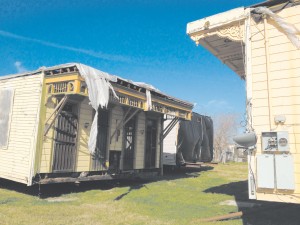Demolition by neglect: Historic homes left to rot by LSU-UMC
23rd January 2012 · 0 Comments
By Christopher Tidmore
Contributing Writer
Despite assurance from the State to save several of the remaining historic houses on the 37-acre University Medical Center footprint, only eight have made it through a move off the hospital site — but still seem to be in the process of being “demolished by neglect,” according to Sandra Stokes of the Foundation for Historical Louisiana.
The Louisiana Weekly has learned that the eight houses moved from UMC site (bordered by S. Galvez, Claiborne Ave., Canal St., and Tulane Ave.) have been staged behind Sojourner Truth School with no roofs, walls opened to the elements, and only ill attached plastic to protect the nearly irreplaceable Victorian innards.
As Mid-City neighborhood activist Brad Ott explained, “Once they moved [the houses], they took the roofs off those houses to get them under power lines and them left them…where they were relocated without the immediate remediation, which is putting roofs on them, dealing with their elevation, and securing them.”
Ott explained that this was only the most recent example of property neglect by LSU-UMC officials charged with relocating historic properties to other parts of New Orleans off of the VA-UMC tract in Mid-City. “About 70 houses (from the VA site] had been located to surrounding neighborhoods. Many of them still do not have roofs.”
“Unfortunately all the residents have been moved from the area, 27 blocks in lower Mid-City,” he continued. “Few of them followed the houses to their new neighborhoods,” leaving many properties to deteriorate on their new plots. “They did this swap deal where they took peoples’ houses, their land, for pennies on the dollar.” Many lacked the financial resources to relocate with their houses.
However, the eight homes on the Lafitte Greenway marks a clear example of LSU-UMC officials exposing properties to rain and nature — prior to landing them in another Orleans Parish neighborhood.
As Sandra Stokes explained, “There is still no salvation for these houses. They were decapitated — cut into ‘convenient’ sections — put on trailers and corralled into this holding area. But unless they are secured, they won’t survive.”
This comes just weeks after the historic McDonogh No. 11 school was put at a temporary staging site, amidst worries as to whether the 1879 structure will ever be transfered to the former location of the Blood Bank on Tulane Ave.
“The plan laid out by the state at a public meeting,” Sandra Stokes explained to The Louisiana Weekly, “is to take the school’s upper two floors, and place it on a temporary site at the edge of the UMC footprint for about a year. At that time, they will determine whether it is structurally sound enough to be moved a second time to its final location. If it is deemed OK, then at that time, the state will begin to build the base structure and move it again.”
“Why not just move it there first? Why wait a year? .. If you truly wanted to save the building, wouldn’t you strive to move it just once?”
The same thing is happening, the FHL Board member worries, with these shotgun homes. “We certainly appreciate the efforts to save these historic homes, but there needs to be follow-through. If not, you create more problems. This has probably been one of the largest efforts of moving historic homes in the nation. Certainly we want to be able to declare it a success in the end.”
Destruction, rather than preservation, has been a constant theme since LSU began pushing for the construction of the suburban-style 70-acre hospital complex nearly six years ago. For the 19th-century, predominantly African-American neighborhood cleared, LSU and UMC board have shown little sensitivity to preserving the city’s architectural culture, said Stokes. Hundreds of properties have faced the wrecking ball.
“They act like they want us to look like Birmingham. I have nothing against Birmingham. It’s just not New Orleans,” Stokes maintained. “People come here for a reason.” The historical atmosphere that is not being protected, in her view. The fear is soon — it will look like Birmingham.”
Which has brought worries that neo-Gothic beauty of McDonogh 11, like many of the shotgun houses, might not make it to its final destination. “We spent tax dollars fixing this school after Hurricane Katrina. There were students going there two years ago [at a time when there is limited classroom space elsewhere in the city]. What happens if it sits at its temporary location, and LSU decides that it became unsound in the move?”
Attending the International Disaster Expo here in New Orleans last week, Brad Ott recollected, “I spoke to one of the contractors that lost in that [McDonogh 11] bid…In fact, it is sitting, and the prospect looms large that they don’t intend to move it from the site, and it will be demolished.” This, despite, City Council demands and financial commitments to move the property to Tulane Ave.
Attention has already turned to the Veterans Administration plot and the fight to preserve the historic Dixie Brewery. Reuse of a portion of the building is being discussed. But after six years, no work has begun to secure the property.
While Ott notes a greater sensitivity by the VA to preserve at least some of Mid-City properties, “As for Dixie Brewery, I share your concern…We see the threatened loss of the building, if they don’t start doing something.”
“As I understand it, this week the State Historic Preservation Committee is going to look at this very issue.”
This article was originally published in the January 23, 2012 print edition of The Louisiana Weekly newspaper



